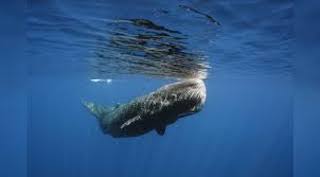A scientific paper released this year provides us with a fascinating glimpse into the nature and intelligence of sperm whales. Whale scientists Hal Whitehead and Luke Rendell conducted an analysis of logbooks kept by whalers in the North Pacific Ocean in the 19th century, and what emerged should prompt us to re-evaluate how we perceive these extraordinary animals. The study concluded that there is compelling evidence that the whales learned to adapt their behaviour in order to avoid being successfully hunted. Further, they were able to communicate what they’d learned to other whales over a wide area.
When sperm whales are confronted with orcas (their only natural predator) they defend themselves by forming tight circles with their tales facing outwards. When attacked by whaling vessels for the first time, this response simply made them easier to hunt. However, within a very short period of time – a matter of just a few years – whalers recorded a 58% reduction in successful hunts, as the whales fundamentally altered their approach to dealing with this new threat.
Sperm whales in this part of the sea were quick to recognize that tactics that work against long known predators will not work against this new type of predator. The ‘traditional’ defensive position was abandoned in favour of fleeing, diving or swimming upwind of the sailing ships. Even among animals we generally consider to be among the most intelligent, such a process of adaptation normally takes a great many generations to evolve. What is so striking about this change is that these new defensive measures were quickly learned and passed on to other whales, and their effect was almost immediate.
Sperm whales were primarily hunted for a special oil in their heads that was a major commodity at the time. Upon spotting a pod in the distance, a whaler would note the sighting in a logbook, and smaller boats would be dispatched to pursue the whales. Watching the engagement from the ship, the whaler would then note in the log whether the hunt resulted in a successful harpoon strike, or whether the boats returned empty. What quickly became obvious is that in this contest between man and whale in the North Pacific, the balance soon shifted more in favour of the whales.
After this initial drop in successful strikes, kill rates remained consistently low from that point on. That is, until new technologies in the 20th century were again to shift the balance. When sails and hand-thrown harpoons were replaced by modern, powered versions, it proved to be too much for the whales to cope with. Their numbers were subsequently reduced to the point that they were listed as an endangered species in the 1970s. With the whaling ‘moratorium’ in place since 1986, the species has been recovering, but they still face a number of serious threats from human activities. These include ship noise and the risk of collisions, sonic blasting, pollution and climate change, among many others.
Researchers tested a number of hypotheses to explain the decrease in strike success. They found that any possible loss of whaling skills over time, or maybe having captured all the most vulnerable whales early on, did not sufficiently explain it. Also, individual whales who survived and learned from their own experience couldn’t account for the rate of decline. Researchers concluded that it had to be that information was being shared between the individual pods. Sperm whales were able to improve their chances of surviving encounters with whalers because they were learning from these contacts, and passing on that knowledge!
Among the sperm whale’s repertoire of vocalizations are loud clicks that can travel distances of several hundred kilometers. This allows them to communicate not only within, but also between pods. Modeling that considered these long-distance communications turned out to be the best estimate to explain the overall reduction in strike success. It’s also interesting that pods who’d been warned to flee were often observed moving against the wind, making it harder for sailing ships to catch them.
Even 19th century whalers had to recognize that they were dealing with a quarry in possession of an unusual degree of intelligence. But what about us, in the 21st century – do such accounts not give us pause as we consider how we continue to treat these animals? Such observations really ought to make us question what we’re doing.
Let’s consider a more modern example, this one involving orcas trapped behind nets at Whidbey Island’s Penn Cove, WA, in August 1970. Having trapped a very large pod, well beyond the numbers they could keep, the hunters went about the work of sorting which ones to capture and which to release. One account from a witness relates that the “cries from the orca families as they were separated still haunt the memories of locals, and even those participating in the capture.”
Much like their sperm whale relatives, these orcas had been getting harder to catch. Having experienced the hunters’ tactics, and familiar with the sound of their boats, some of the orcas “had learned to roll their bodies, laying down their dorsal fins on the water, making them harder to spot. The pods would also split up, parents sending the young in another direction and deploying themselves as decoys.”
That there are men who can witness such things and persist in these activities is unsettling. Fortunately, in this case it was too much for many Washington residents, and hunters were banned from attempting any further captures of orcas in these waters. The state also sued SeaWorld in 1976 for violating its permits during these “violent captures” and, backed by a number of outraged citizens, was able to obtain a favorable ruling from the court. The law came down on the right side this time, but the disturbing fact remains that clear evidence of the intelligence of these whales, and the anguish we were inflicting upon them, was insufficient to deter the men who wished to hunt them.
So that’s where we are then. Even in the face of compelling evidence of cetacean intelligence, there will remain people willing to exploit them for profit, and others willing to engage in the ugly deeds necessary to make that happen. For the rest of us, it falls to good people to take notice, and to say no. These egregious acts of violence against our fellow beings fall well outside the range of what’s morally acceptable, and have no place in a society that wishes to call itself compassionate and just.
For The Orca’s Voice,
Dani, Canadian Cetacean Alliance



Leave a Reply